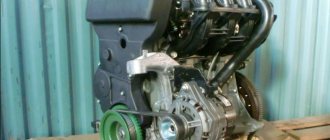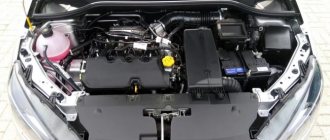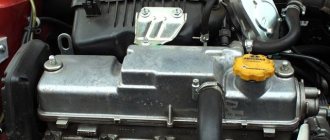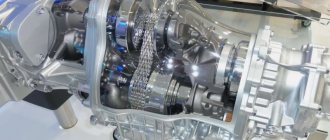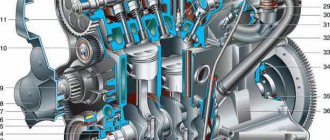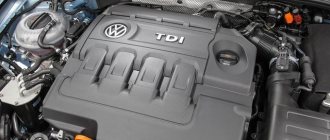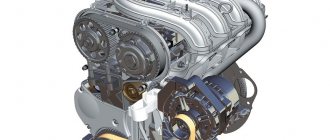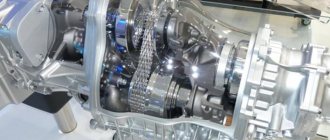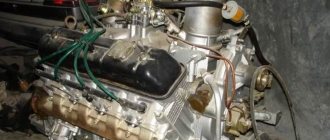For each brand of the company, these engines have certain differences. Audi cars most often use TFSI engines, which are known to almost every fan of this German brand.
There are many myths built around this type of unit. Many believe that the letter F in the name means absolutely nothing, but was added simply to differentiate the model lines. And TSI engines, according to even some experts, are completely identical to TFSI engines. But this is not true, since they are built on different foundations. Today we will talk both about these engines separately and in terms of comparison with Volkswagen TSI engines.
What is TFSI - decoding and technology features
These motors borrowed their original technology from older FSI engines. The VAG 2.0 FSI engine, which was installed on Skoda, Seat and Volkswagen, was very popular. This is a naturally aspirated engine with direct fuel injection into the cylinders. The unit has a fairly reliable foundation, a well-designed design and a fairly long service life.
TFSI engine stands for Turbo Fuel Stratified Injection. The name indicates that this is a turbocharged engine with direct fuel injection into the combustion chambers. Here are some features of a turbo engine:
- Changed pistons. Especially for the turbocharged version, the upper part of the pistons was changed; they received large recesses for operation with reduced compression.
- Improved efficiency and reduced emissions compared to the old FSI to accommodate the new engine's challenging environmental regulations.
- The designers changed the shape and operating features of the crankshaft and connecting rods. The changes also affected the quality of the material; the manufacturer increased it for turbo engines.
- The intake and exhaust systems also received changes, they became more precise and efficient, which was vital for the compressor version.
- Of course, the designers had to install a more powerful and reliable fuel pump. This ensured the elasticity of the engine at high speeds.
Basic concepts explain what a TFSI engine is, how it works, and what its main advantages are. If you have ever come across FSI engines from VAG, then you know that they were the most reliable and successful mid-class naturally aspirated engines. Many of them reach 500,000 km without repairs or intervention. It is enough to maintain the unit well and pour expensive oil at the right time.
First acquaintance with the engine
To begin with, some car enthusiasts do not even understand what kind of TFSI engine this is and how this abbreviation stands for.
This means Turbo fuel stratified injection. In translation here we are talking about a turbo engine with stratified fuel injection. Yes, this is indeed in many ways an analogue of the FSI, only additionally equipped with a turbocharger.
The system was revolutionary for its time, since it was the Germans who were the first to use direct injection into the chamber for each piston separately, managing to connect this with a turbine.
But the decoding of the TFSI marking itself does not yet make it possible to fully recognize this engine. And be sure to compare with TSI.
Many theories, conjectures and myths were built around the motor with the designation TFSI. Some are sure that the letter F has no meaning at all, and this was done solely for the sound of the name, or for the difference in the model range of cars. Allegedly, TSI comes on Volkswagen and Skoda models, and TFSI exclusively on Audi.
You have already become familiar with how the TFSI value is deciphered. But it is equally important to understand what this same TFSI actually means, how it differs from its supposed counterpart, and what the situation looks like in reality.
The technology of the engines in question is based on older internal combustion engines, which have already been discussed here. This is FSI. One of these 2.0-liter engines was actively used in various models under the Seat, Skoda and Volkswagen brands. This is an atmospheric internal combustion engine equipped with a direct injection system. The engine has a reliable base, high-quality design and long service life.
But now cars of more recent generations are equipped with TFSI engines. Their decoding has already made it clear that we are talking about a turbo engine with direct injection. But it has its own important features. In many ways, this will allow us to understand the operating principle of the TFSI series units.
- Other pistons. To improve the performance of the turbocharged engine, the upper part of the pistons has undergone certain changes. New larger recesses are provided here, which allows you to work effectively in conditions of reduced compression.
- Increased efficiency of the internal combustion engine with a parallel reduction in the amount of harmful emissions. This distinguishes the turbocharged version from the naturally aspirated one. This was done in order to comply with new stringent environmental standards.
- Crankshafts and shafts. The principle of operation has changed largely due to the modified form. Additionally, designers use high-strength materials for their manufacture, which allows them to withstand the loads from the turbine.
- Intake and exhaust system. And here changes have occurred. They were aimed at increasing precision and efficiency, since this is one of the main requirements for an internal combustion engine when using a turbocharger.
- Fuel pump. It has become more powerful and reliable. Due to this, it was possible to improve the elasticity of operation at high speeds.
We recommend: How the suspension of a modern car works in simple words
The changes made and the announced features of the engine in question largely make it clear what kind of engine it is, how it works and what its strengths are.
But there is still no escape from comparison with FSI, although most often it is compared with TSI, since both engines are turbocharged.
I would like to remind you that in the middle class of cars, the naturally aspirated FSI is considered one of the best engines in the world. Many such engines can easily cover a range of 400-500 thousand kilometers without requiring expensive repairs or serious intervention. The only condition for long-term operation is high-quality maintenance and the use of suitable motor oils.
Now, having figured out what TFSI means, you should compare TSI and TFSI, look at their capabilities and understand whether the new generation is really noticeably superior to its conventional predecessor.
What is the difference between TSI and TFSI engines?
TSI motors are built on a different technology. To produce this engine, the Volkswagen concern did not take old naturally aspirated engines, but built a new unit. It has an intake manifold, two turbines, one of which is electric and runs almost constantly. The second mechanical turbine has a classic design. That is, at its core it is a bi-turbo engine.
The main differences from the TFSI also lie in the fact that Volkswagen did not provide a decent design for the cylinder block itself, so the service life of TSI engines does not always reach 200,000 km. And the turbines themselves bring owners a lot of trouble, especially if maintenance regulations are violated. 1.4 TSI engines developed before 2012 have special vagaries.
Today, various design bureaus are engaged in the development and continuation of the series of these two units. TFSI technology was taken over by the Audi concern, and TSI is installed on VW, Skoda and Seat. However, there are already rumors about the creation of a new single platform for the production of smaller turbocharged engines.
Characteristics of the EA113 engine
| Production | Plant Audi Hungaria Motor Kft. in Gyor |
| Engine make | EA113 |
| Years of manufacture | 2004-2014 |
| Cylinder block material | cast iron |
| Supply system | direct injection |
| Type | in-line |
| Number of cylinders | 4 |
| Valves per cylinder | 4 |
| Piston stroke, mm | 92.8 |
| Cylinder diameter, mm | 82.5 |
| Compression ratio | 10.5 |
| Engine capacity, cc | 1984 |
| Engine power, hp/rpm | 170-271/4300-6000 |
| Torque, Nm/rpm | 280-350/1800-5000 |
| Fuel | 98 95 (lower power) |
| Environmental standards | Euro 4 Euro 5 |
| Engine weight, kg | ~152 |
| Fuel consumption, l/100 km - city - highway - mixed. | 12.6 6.6 8.8 |
| Oil consumption, g/1000 km | up to 500 |
| Engine oil | 5W-30 5W-40 |
| How much oil is in the engine | 4.6 |
| When replacing, pour, l | ~4.0 |
| Oil change carried out, km | 15000 (better 7500) |
| Engine operating temperature, degrees. | ~90 |
| Engine life, thousand km - according to the plant - in practice | — ~300 |
| Tuning, hp — potential — without loss of resource | 400+ ~250 |
| The engine was installed | Audi A3 Audi A4 Audi A6 Audi TT / TTS Seat Altea Seat Exeo Seat Leon Seat Toledo Skoda Octavia vRSVolkswagen Jetta Volkswagen Golf V GTI / VI GTI 35 Ed./ R Volkswagen Passat Volkswagen Polo R |
Main disadvantages and advantages of TFSI technology
As mentioned above, the difference between TSI and TFSI is obvious, and it is not in favor of the first technology. Motors with the letter F in the designation are larger and have a much longer lifespan. The turbines themselves, subject to good maintenance, do not break down up to 300,000 km and 10 years of operation. The list of advantages includes very moderate fuel consumption, given the high power that the company squeezes out of these developments.
Now let's talk a little about the disadvantages of technology:
- engines with turbines have lost their unpretentiousness and omnivorousness, they need good refueling;
- the cost of maintenance has increased significantly, you have to fork out for expensive oils and filters;
- the cost of repairs will be enormously high; all spare parts must be original and expensive;
- high oil consumption is a design feature of engines; you will have to occasionally add lubricant;
- A chain is installed in the timing system, and this causes certain disadvantages in the form of stretching of the chain drive.
All the disadvantages are due to the fact that the engine was produced in great haste in order to install it on cars before the introduction of new environmental standards. Many shortcomings no longer apply to the current generation TFSI engines, but are found only on engines produced in 2012-2014. Otherwise, there are no significant disadvantages with the units; there are no childhood problems or common problems up to mileage limits of 200-250 thousand km.
Decoding the block encoding:
| Byte 00 | Manufacturer |
| 01 | Audi |
| 02 | Skoda |
| 03 | Seat |
| 04 | Volkswagen |
| Byte 01 | Model |
| 03 | Audi A3 (8P) / Seat Altea/Toledo (5P) / Seat Leon (1P) / Skoda Octavia (1Z) / VW Golf (1K) |
| 04 | Audi A4 Limousine (8EC) / VW Passat (3C) |
| 05 | Audi A6 Limousine (4F2) |
| 0C | Audi A4 Avant (8ED) |
| 0D | Audi A6 Avant (4F5) |
| 13 | Audi TT Coupé (8J) |
| 14 | Audi A5 Coupé (8T) |
| 1C | Audi A4 Cabriolet (8H) / VW Eos (1F7) |
| 23 | VW Tiguan (5N) |
| Byte 02 | Market |
| 00 | Europe/Rest of World (RoW) |
| 01 | North America |
| 02 | Russia (GUS) / China |
| 04 | South Africa |
| 08 | Mexico / Taiwan / Korea |
| Byte 03 | Pollution |
| 00 | EU-II |
| 03 | EU-IV |
| 06 | USA LEV |
| 0A | USA ULEV II |
| Byte 04 | checkpoint |
| 02 | Automatic transmission “multitronic” (01J) |
| 18 | 6 speed manual transmission |
| 19 | Automatic transmission (09L) |
| 1C | 6-speed direct shift gearbox (DSG/02E) |
| Byte 05 | Special functions I |
| 03 | Front-wheel drive (FWD) / Without climate control |
| 07 | Front wheel drive (FWD) / Climate control |
| 0C | All-wheel drive (AWD) / Without climate control |
| 0F | All-wheel drive (AWD) / Climate control |
| Byte 06 | Special functions II |
| Bit 0 | Cruise control |
| Bit 1 | Adaptive Cruise Control (ACC) |
| Bit 2 | Suspension with variable ground clearance |
| Bit 3 | Trailer installed |
| Byte 07 | Cooling |
| 18 | 1 Cooling fan |
| 20 | 2 Cooling fans |
| 60 | 2 Cooling fans + additional water pump |
Summary - what to consider when buying a car with TFSI?
If you buy a new car with such a unit, you can safely buy a car with any engine size. Audi specialists have done everything possible to ensure that the engines last a long time and do not require any repairs. But used options require more careful selection and inspection. It is important to carry out diagnostics, find out the actual mileage, and clarify the quality of service. From these factors it is already possible to form a definite opinion about the machine and its potential resource.
In general, TFSI units are considered reliable and of high quality. In their nature, they repeat almost all the advantages of the once popular FSI series; today the engines continue the glorious line of reliable VAG engines, to which there are practically no complaints. And this is how they differ from the new TSI development.
Volkswagen-Audi 2.0 TFSI engine tuning
Chip tuning
Tuning TFSI engines is quite a simple task (if you have money), to increase engine power to 250-260 hp, just go to a tuning office and upgrade to Stage 1. If this power is not enough, then it is worth installing an intercooler, 3″ exhaust pipe, cold intake, more efficient injection pump and flashing, this will increase the output to 280-290 hp. Further increase in power can be continued using the new K04 turbine and injectors from the Audi S3, such configurations give ~350 hp. Further squeezing the juices out of a 2-liter engine is not so profitable, the price/hp ratio is decreases noticeably.
ENGINE RATING: 4+
<<BACK
Decoding TFSI engine. Everything about him + interesting facts
It is better to find out what the TFSI engine decoding means in advance, when different options for cars offered for purchase are being considered.
If your financial capabilities allow, you should strive to purchase the highest quality car, including technical characteristics - it will last you for many years. But the engine is still one of the main components of the car. It depends on him how powerful the car is, how quickly it can accelerate and how much it can carry. Therefore, it is better to try and decipher any suspicious prefixes to the name and marking of the engine immediately, so as not to guess later and expect surprises from this chosen car that were not planned by its owner.
The decoding of the TFSI engine is quite simple: the abbreviation stands for Turbocharged Fuel Stratified Injection, that is, a turbocharged injection engine. Many people mistakenly consider it an analogue of TSI, and are deeply mistaken - the engines differ from each other not only in characteristics, but also in structure. This type of engine is quite different from the FSI, although it has common features with it. Let's take a closer look at the qualities and principles of these different motor options.
Dispelling misconceptions
How is TFSI different from TSI? Both engines are turbocharged, and in this regard, it would seem equal. However, TSI has 2 differences:
- Fuel is not supplied directly into the cylinders, but into a special intake manifold;
- The design contains a so-called duplicate turbocharging. The engine is equipped with both a mechanical turbine - it is forced to work by exhaust gases - and an electric compressor, which forcibly increases the air pressure under any circumstances. They work alternately, connecting and disconnecting depending on the operating mode of the engine.
In this regard, the TSI is more economical and responsive than the TFSI.
This is not surprising: after all, this is a more modern development of the same Volkswagen concern. Thus, decoding the TFSI engine, along with a similar interpretation of the abbreviations TSI and FSI, will easily help you figure out how modern the car you are looking at is.
Malfunctions and repairs
As mentioned earlier, TFSI power units are oil guzzlers. Of course, you can change the oil for summer and winter, but for most owners this is not a solution, but only a delay in increasing lubricant consumption. This problem occurs on many power units produced by the VW-Group.
TFSI engine for Skoda
The second significant malfunction, which occurs quite often, is stretching of the timing chain. At the same time, the meeting of pistons and valves begins, which causes a characteristic metallic knock that even auto mechanics have been looking for for a long time.
